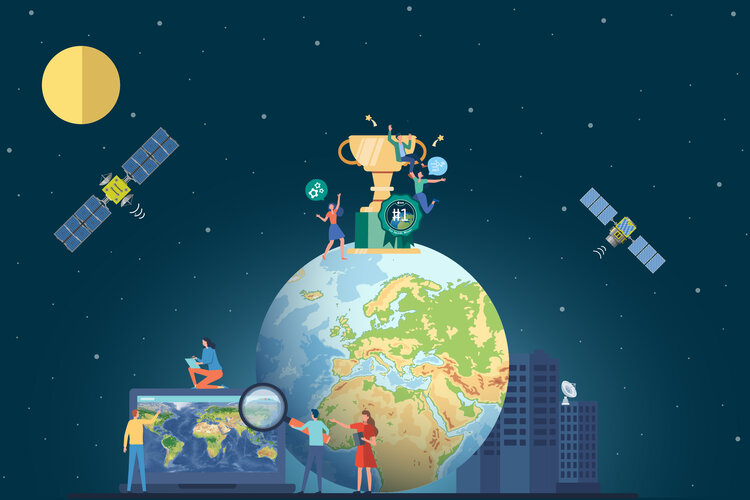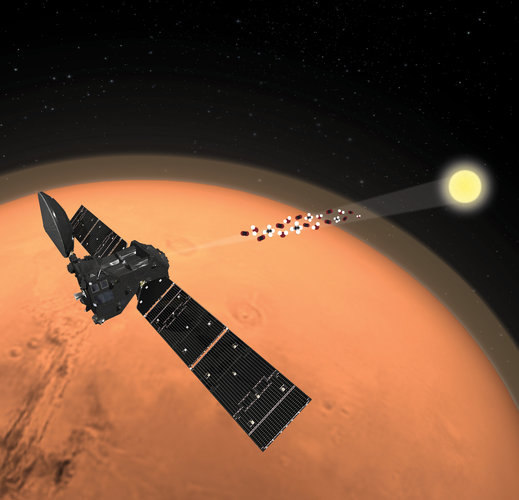
Copernical Team
Artificial gravity provides partial protection for biology in space

Space travel to the moon, Mars, and beyond can expose astronauts to extreme conditions, causing potential health issues. To prepare for future long-duration missions, NASA studies how the effects of space—changes in gravity, radiation, and more—impact "model organisms," or other kinds of life that are biologically similar to humans. New findings from a study using fruit flies on the International Space Station suggest that space travel has an impact on the central nervous system, but that artificial gravity provides partial protection against those changes.
"Microgravity poses risks to the central nervous system, suggesting that countermeasures may be needed for long-duration space travel," said Dr. Janani Iyer, a Universities Space Research Association (USRA) project scientist at NASA's Ames Research Center in California's Silicon Valley and an author on the paper published today in Cell Reports.
ESA–EGU Excellence Award 2023 open for nominations

Following the success of the inaugural ESA–EGU Earth Observation Excellence Award in 2021, it’s now time to lodge your nomination for someone or for a team that deserves recognition for their innovative use of Earth observation. The call for nomination opens today and will close on 7 December.
The award winners will be announced and presented at the European Geosciences Union (EGU) General Assembly, which takes place on 23–28 April 2023.
New plasma tech for oxygen, fuel and fertiliser from Mars' atmosphere

Using novel plasma reactors, researchers have shown that it is possible to extract key ingredients from Mars' carbon dioxide-rich atmosphere to provide future astronauts with oxygen, fuel and fertiliser. This technological leap could make it viable for humans to live on Mars.
Astronomers obtain sky's large-field X-ray maps
 Chinese astronomers have released the world's first collection of large-field X-ray maps of the sky, captured by a small satellite put into orbit last month.
The Wide-field X-ray Telescope, launched into orbit on July 27 by a solid-propellant-fuelled rocket, is the first large-field X-ray imaging telescope, according to the National Astronomical Observatory of China.
After a four-day
Chinese astronomers have released the world's first collection of large-field X-ray maps of the sky, captured by a small satellite put into orbit last month.
The Wide-field X-ray Telescope, launched into orbit on July 27 by a solid-propellant-fuelled rocket, is the first large-field X-ray imaging telescope, according to the National Astronomical Observatory of China.
After a four-day Why do galaxies stop making stars
 Six billion years ago, two galaxies were colliding, their combined forces hurling a stream of gas hundreds of thousands of light years away. Reported this week by a team including Pitt astronomers, that unusual feature provides a new possible explanation for why galaxies stop forming stars.
"One of the biggest questions in astronomy is why the biggest galaxies are dead," said David Setton,
Six billion years ago, two galaxies were colliding, their combined forces hurling a stream of gas hundreds of thousands of light years away. Reported this week by a team including Pitt astronomers, that unusual feature provides a new possible explanation for why galaxies stop forming stars.
"One of the biggest questions in astronomy is why the biggest galaxies are dead," said David Setton, Massive stars' blasts hitting Orion's sword mapped in unprecedented detail
 Astronomers using W. M. Keck Observatory on Hawaii Island have captured from Maunakea the most detailed and complete images ever taken of the zone where the famed constellation of Orion gets zapped with ultraviolet (UV) radiation from massive young stars.
This irradiated neutral zone, called a Photo-Dissociation Region (PDR), is located in the Orion Bar within the Orion Nebula, an active s
Astronomers using W. M. Keck Observatory on Hawaii Island have captured from Maunakea the most detailed and complete images ever taken of the zone where the famed constellation of Orion gets zapped with ultraviolet (UV) radiation from massive young stars.
This irradiated neutral zone, called a Photo-Dissociation Region (PDR), is located in the Orion Bar within the Orion Nebula, an active s Teams continue to review options for next Artemis I launch attempt
 After standing down on Saturday's Artemis I launch attempt when engineers could not overcome a hydrogen leak in a quick disconnect, an interface between the liquid hydrogen fuel feed line and the Space Launch System (SLS) rocket, mission managers met and decided they will forego additional launch attempts in early September.
Over the next several days, teams will establish access to the ar
After standing down on Saturday's Artemis I launch attempt when engineers could not overcome a hydrogen leak in a quick disconnect, an interface between the liquid hydrogen fuel feed line and the Space Launch System (SLS) rocket, mission managers met and decided they will forego additional launch attempts in early September.
Over the next several days, teams will establish access to the ar ALMA witnesses deadly star-slinging tug-of-war between merging galaxies
 While observing a newly-dormant galaxy using the Atacama Large Millimeter/submillimeter Array (ALMA) and the Hubble Space Telescope (HST), scientists discovered that it had stopped forming stars not because it had used up all of its gas but because most of its star-forming fuel had been thrown out of the system as it merged with another galaxy. The result is a first for ALMA scientists. What's m
While observing a newly-dormant galaxy using the Atacama Large Millimeter/submillimeter Array (ALMA) and the Hubble Space Telescope (HST), scientists discovered that it had stopped forming stars not because it had used up all of its gas but because most of its star-forming fuel had been thrown out of the system as it merged with another galaxy. The result is a first for ALMA scientists. What's m Far-infrared detector KID reaches highest possible sensitivity
 Compared to most other wavelengths, astronomy has a blind spot in the area of far-infrared radiation. A far-infrared space telescope can only utilize its full sensitivity with an actively cooled mirror below 4 Kelvin (-269 C). Such a telescope doesn't exist yet, which is why there has been little worldwide investment in the development of corresponding detectors.
In 2004, SRON decided to b
Compared to most other wavelengths, astronomy has a blind spot in the area of far-infrared radiation. A far-infrared space telescope can only utilize its full sensitivity with an actively cooled mirror below 4 Kelvin (-269 C). Such a telescope doesn't exist yet, which is why there has been little worldwide investment in the development of corresponding detectors.
In 2004, SRON decided to b Astronomers show massive stars can steal Jupiter-sized planets
 Jupiter-sized planets can be stolen or captured by massive stars in the densely populated stellar nurseries where most stars are born, a new study has found.
Researchers from the University of Sheffield have proposed a novel explanation for the recently discovered B-star Exoplanet Abundance STudy (BEAST) planets. These are Jupiter-like planets at large distances (hundreds of times the dist
Jupiter-sized planets can be stolen or captured by massive stars in the densely populated stellar nurseries where most stars are born, a new study has found.
Researchers from the University of Sheffield have proposed a novel explanation for the recently discovered B-star Exoplanet Abundance STudy (BEAST) planets. These are Jupiter-like planets at large distances (hundreds of times the dist 





























